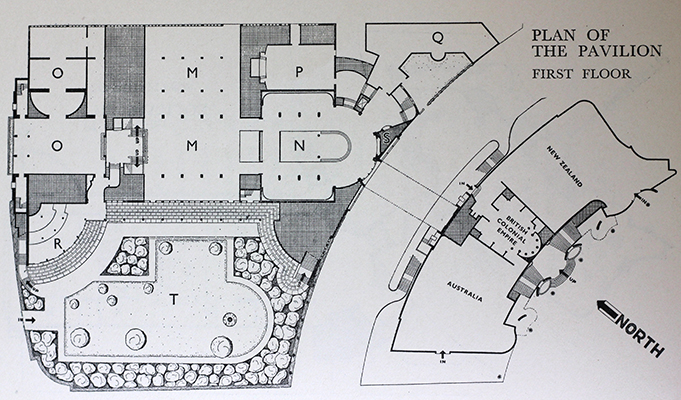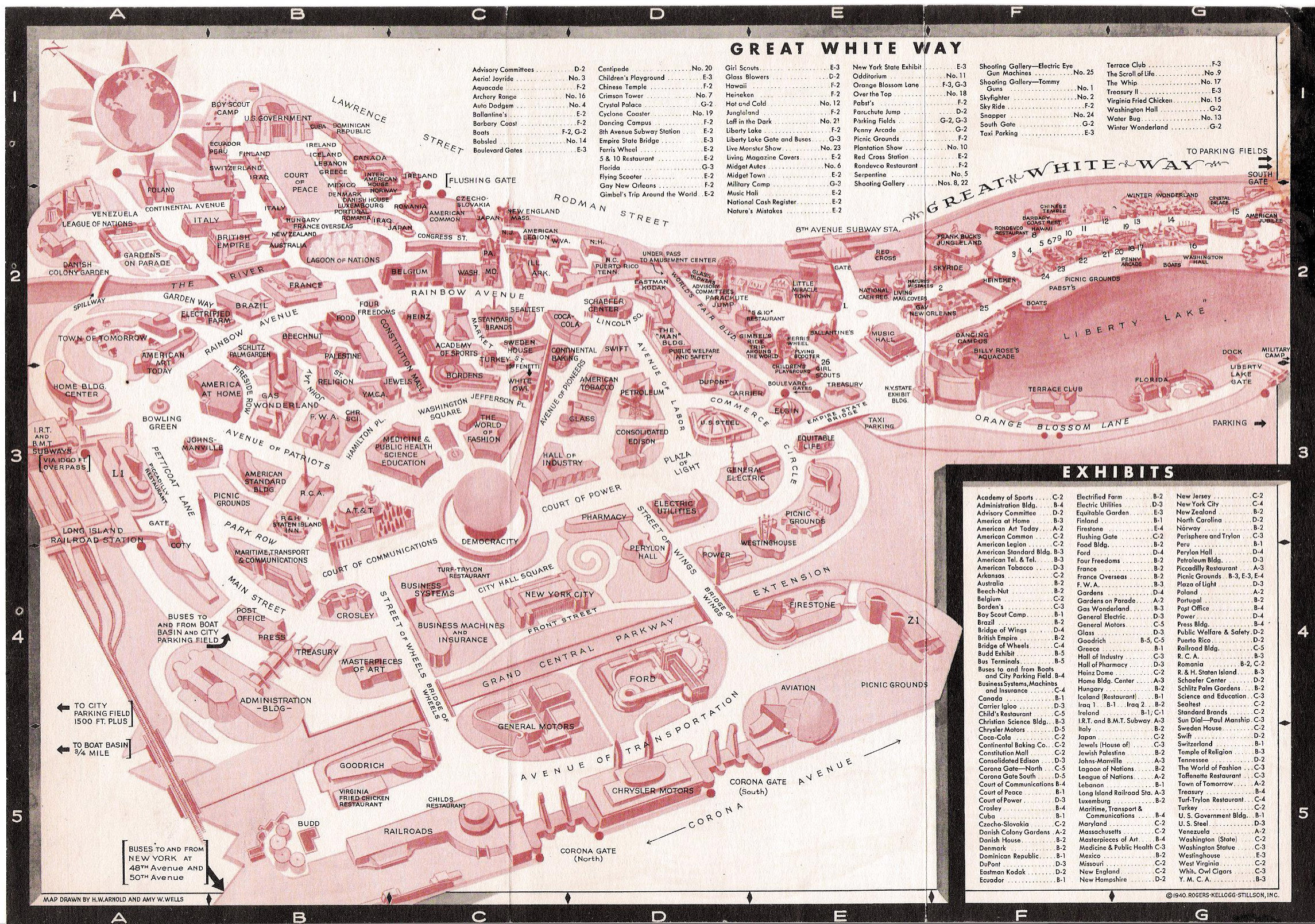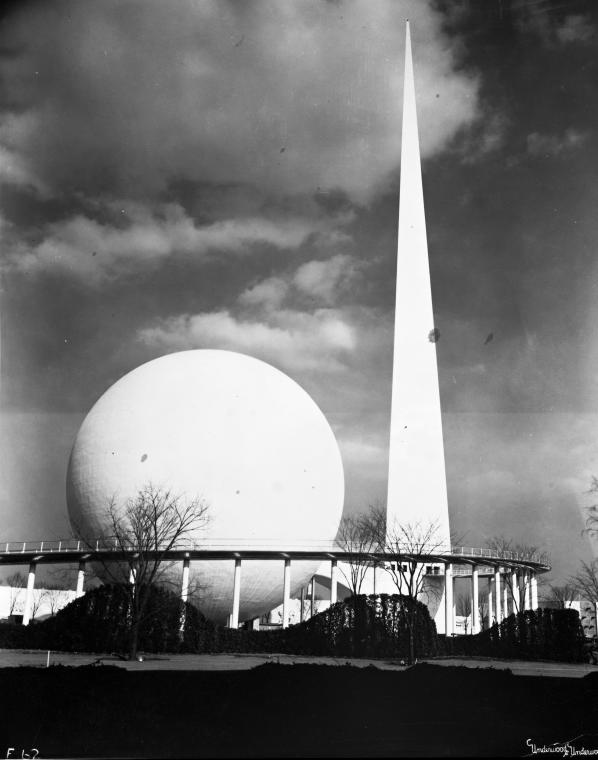Saturday, May 2, 2015
The British Pavilion & The Common Heritage of Democracy
When a nation decides to participate in a world fair, it is their responsibility to create a pavilion that simultaneously blends in with and stands out from the rest of the grounds and to design an exhibition that corresponds to the fair theme. Let's take a look at the British pavilion, which succeeded on both fronts.
The British pavilion was located to the left of the Lagoon of Nations. It consisted of two buildings linked by a bridge. The larger building housed the United Kingdom hall while the smaller south building houses the halls of the British Colonial Empire (including territories in East and West Africa, Far East, West Indies, Mediterranean and Indian Ocean), Australia, and New Zealand.
The buildings were large and stately, with sleek lines, giving it a monumental yet modern feel. Flanking the entrance stood two gilded lions, accompanied by other lions founded in bas-relief on the walls.
The British Pavilion's answer to the "Democracy and World of Tomorrow" theme was to show the British legacy behind American democracy and its founder, George Washington. The exhibition featured an extensive Washington family tree proving him to be a direct descendant of King John, who granted the Magna Carta, and nine of the twenty-five barons who signed it. The exhibition even featured one of the four original copies of the Magna Carta. The link between British tradition and American democracy was of the utmost importance to the British, who, a few weeks after the fair opened, planted a seedling royal oak from Windsor Great Park on the fair grounds.
Thursday, April 16, 2015
The Introduction of the Television
As the fair's theme was "Building the World of Tomorrow," it is to be expected that the 1939 New York World Fair would be provided with an array of new technology to marvel at. The most notable piece of technology to have debuted at the fair is the television.
RCA introduced the television to the American public in anticipation of the fair's opening, publishing a brochure to explain its features. The introduction of the television was inextricably linked to the fair itself. When the fair opened on April 30, 1939 it was accompanied by the first U.S. television broadcast, featuring President Roosevelt's inaugural remarks for the fair as he welcomed the nearly 200,000 visitors that filled the fair grounds on that first day. The opening ceremonies were broadcast by NBC who then went on to provide regularly scheduled programming.
As RCA was the primary provider of the television, their pavilion exhibited the television set with its many intricacies. RCA had TRK-12 television sets on display to expose the public to television, which had a brighter display than sets that were mass produced for the consumer, such as the 630-TS (pictured on the right). Visitors could see themselves on television and Radiograms, which could be sent to friends and family, documented the experience.
Visitors were understandably skeptical of the new technology and many thought it was a trick. To thwart suspicions RCA made and displayed a television set with a transparent case so that its mechanisms could be observed in action.
RCA was not the only television manufacturer featured at the fair. Sets by General Electric and DuMont were also used. Television demonstrations were popular not just in these manufacturer pavilions but also in the pavilions of Westinghouse, General Motors, and Crosley.
RCA introduced the television to the American public in anticipation of the fair's opening, publishing a brochure to explain its features. The introduction of the television was inextricably linked to the fair itself. When the fair opened on April 30, 1939 it was accompanied by the first U.S. television broadcast, featuring President Roosevelt's inaugural remarks for the fair as he welcomed the nearly 200,000 visitors that filled the fair grounds on that first day. The opening ceremonies were broadcast by NBC who then went on to provide regularly scheduled programming.
As RCA was the primary provider of the television, their pavilion exhibited the television set with its many intricacies. RCA had TRK-12 television sets on display to expose the public to television, which had a brighter display than sets that were mass produced for the consumer, such as the 630-TS (pictured on the right). Visitors could see themselves on television and Radiograms, which could be sent to friends and family, documented the experience.
Visitors were understandably skeptical of the new technology and many thought it was a trick. To thwart suspicions RCA made and displayed a television set with a transparent case so that its mechanisms could be observed in action.
RCA was not the only television manufacturer featured at the fair. Sets by General Electric and DuMont were also used. Television demonstrations were popular not just in these manufacturer pavilions but also in the pavilions of Westinghouse, General Motors, and Crosley.
Sunday, April 12, 2015
Sunday, February 22, 2015
The Grounds - Layout and Themes

The 1939 World's Fair sprawled over 1,200 acres of the Flushing Meadows-Corona Park in Queens, one of the five boroughs of New York City. The fair was divided into seven thematic zones: the Government Zone, the Community Interests Zone, the Food Zone, the Communication and Business Zone, the Production and Distribution Zone, the Transportation Zone and the Amusement Zone.
The majority of these zones were laid out around the theme center, with the exception of the Amusement Zone, which wrapped around Fountain Lake, to the right of the rest of the fair grounds.
The theme center consisted of two all-white buildings which would become the symbol of the fair. These buildings were called the Trylon, which was over 700 feet tall, and the Perisphere. Visitors entered these buildings through a moving stairway and exited via a large curved walkway named the "Helicline." Inside the Perisphere visitors found a model of the city of tomorrow, viewed from an elevated moving walkway suspended above floor level. These theme buildings embodied the theme of the entire fair: "Building the World of Tomorrow."
One of the most interesting parts of the fair plan is the corridor of buildings that ran from the top of the Government Zone to the bottom of the Transportation Zone.

At the top of the Government Zone, facing the rest of the fair grounds, is the U.S. Government building. This building casts its shadow over the 'Court of Peace', flanked on either side by buildings for several countries, such as Ireland, Greece, and Mexico.

 Next along this corridor is the 'Lagoon of Nations', an oval-shaped fountain around which other nation buildings are arranged, such as those for France and Belgium. After this a stretch titled the 'Constitutional Mall' stretches all the way to the center of the fair grounds, which held its two landmark buildings: the Trylon and the Perisphere. By this point we have reached the opposite end of this long corridor which contains the New York City building, as well as the buildings for Ford, General Motors, and finally Chrysler Motors, a large building that faces the U.S. government building. As the fair's theme was centered around building the world of tomorrow, the decisions around this corridor are interesting ones to dissect. First, the parallels between the lay out of this corridor and that of the National Mall and surrounding buildings in Washington D.C. Secondly, its important to note the prominent placement of the buildings belonging to car manufacturers. The coupling of this with the architectural reference to the nation's capitol seems to echo the fair's theme, professing a future that combines key elements of democracy and technology.
Next along this corridor is the 'Lagoon of Nations', an oval-shaped fountain around which other nation buildings are arranged, such as those for France and Belgium. After this a stretch titled the 'Constitutional Mall' stretches all the way to the center of the fair grounds, which held its two landmark buildings: the Trylon and the Perisphere. By this point we have reached the opposite end of this long corridor which contains the New York City building, as well as the buildings for Ford, General Motors, and finally Chrysler Motors, a large building that faces the U.S. government building. As the fair's theme was centered around building the world of tomorrow, the decisions around this corridor are interesting ones to dissect. First, the parallels between the lay out of this corridor and that of the National Mall and surrounding buildings in Washington D.C. Secondly, its important to note the prominent placement of the buildings belonging to car manufacturers. The coupling of this with the architectural reference to the nation's capitol seems to echo the fair's theme, professing a future that combines key elements of democracy and technology.
Subscribe to:
Posts (Atom)






